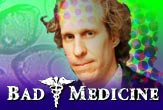Magnet Therapy Proves Effective ... in Attracting Your Money

Is there a weekend warrior on your shopping list hoping for magnetic insoles or wristbands to ease the pain of aching joints? Here's a little tip to save you a bundle: Buy a 50-cent refrigerator magnet and glue it to a piece of cloth.
This is guaranteed to be as effective in relieving pain as a slick $50 magnet-therapy product. That is, it won't be effective at all.
| Bad Medicine |
| Bad Medicine appears each Tuesday on LiveScience. Previous columns: |
Magnet therapy is older than the holidays themselves. But don't let the millennia-old healing tradition fool you. That great suction force you might feel is just money leaving your wallet.
Fatal attraction
Magnet therapy refers to healing with static magnets, the kind of basic magnet commonly found holding up notes and crayon artwork on a refrigerator. Products include magnetic belts, mattress pads, bracelets, bandages and shoe inserts. It's a $5 billion worldwide business, according to the National Center for Complementary and Alternative Medicine.
Like many forms of alternative medicine, if magnet therapy works—and most studies find no positive effect or, at best, a statistically marginal effect attributed to the placebo effect—it would have to involve some novel biological mechanism.
A top claim made by proponents is that magnets attract the iron in blood and improve blood flow, reducing pain. They only trouble with this theory is that iron in blood is bound to hemoglobin and is not attracted by magnets. You can test this, if you're brave, with a pinprick of blood.
Get the world’s most fascinating discoveries delivered straight to your inbox.
| Other Debunkings |
| Licensed to Kill: Some Doctors are Real Naturals |
Then again, if blood were attracted to magnets, when you enter under the powerful magnets of an MRI machine, which are thousands of times stronger that so-called therapeutic magnets, you'd blow up.
Yes, your earthly pain would be gone.
Going deep
Magnet therapy got a huge kick in the 1990s with a string of sports celebrity endorsements, such as one from the injured Miami Dolphin's quarterback Dan Marino. Marino no doubt knows pain: The Hall-of-Fame passer lost nearly a dozen playoff games, never won a Super Bowl, and now toils as a spokesperson for such contradicting entities as Papa John's and NutriSystem. What reduced his pain, if anything, was likely the million-dollar around-the-clock care he received as a professional athlete.
A few small studies have found marginal benefits, such as a 1997 study from Baylor College of Medicine involving 50 patients with knee pain. This is the study most cited by purveyors of magnetic goods.
Conversely, the dozen or so larger studies since 1997 finding no benefit from magnets are the least likely to be cited. The Baylor study has never been replicated, which in the world of medical studies can mean that a study's methods were flawed or that the results for some reason simply don't stick in the real world.
| Painful Reading |
| The Pain Truth: How and Why We Hurt |
Don't confuse static magnets, however, with electromagnets, devices used in hospitals and involving pulses of electricity shown to help heal bone fractures. While experimental, the therapy is promising and likely relies on the "electric" part of electromagnetism affecting cell membranes or nerve cells.
Ho-ho hopeless
Most commercial magnet therapy products are no stronger than a refrigerator magnet, at about 50 gauss. If you're willing to shell out $15 for magnetic shoe inserts, you can try this little test: You'll see that the insole will attract a paperclip. Now cover it with a sock. Hold the insole vertically and you might see the paperclip just barely clinging. Now add about a dozen sheets of paper to simulate the thickness of skin. Not a chance.
Commercial magnets typically are not strong enough to penetrate their casing (foam or cloth) and our casing (skin) to have any effect on things they can't affect anyway, like blood. Some manufactures are now offering magnets as strong as 200 gauss to ease this criticism.
This change would imply that the stronger magnets are, say, four times more effective at treating pain than weaker magnets, which is yet one more aspect of magnet therapy that hasn't been proven. But as long as the magnet makers are attracting your money, they aren't too concerned.
Christopher Wanjek is the author of the books “Bad Medicine” and “Food At Work.” Got a question about Bad Medicine? Email Wanjek. If it’s really bad, he just might answer it in a future column. Bad Medicine appears each Tuesday on LIveScience.
Related Stories
- It's on the Web; It Must Be True
- Discovery Could Lead to Reversal of Arthritis
- Lots of Cash Spent on Mythical Fountains of Youth
More to Explore
- Life's Little Mysteries
- Human Nature: What We Learned in 2006
- Top 10 Bad Things That Are Good For You
- The Weirdest Science Stories of 2006
- The Most Popular Myths in Science

Christopher Wanjek is a Live Science contributor and a health and science writer. He is the author of three science books: Spacefarers (2020), Food at Work (2005) and Bad Medicine (2003). His "Food at Work" book and project, concerning workers' health, safety and productivity, was commissioned by the U.N.'s International Labor Organization. For Live Science, Christopher covers public health, nutrition and biology, and he has written extensively for The Washington Post and Sky & Telescope among others, as well as for the NASA Goddard Space Flight Center, where he was a senior writer. Christopher holds a Master of Health degree from Harvard School of Public Health and a degree in journalism from Temple University.
 Live Science Plus
Live Science Plus





